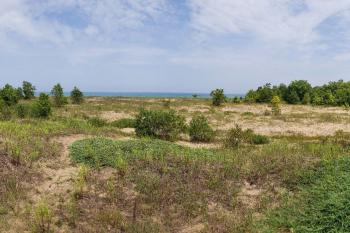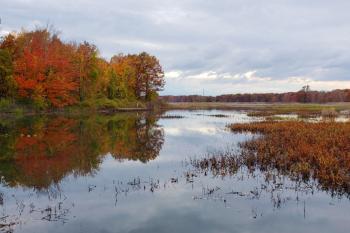Objective, Commitments & Measures
Objective:
2.3. Provide ecosystem and human benefits through prioritized and collaborative invasive species control efforts.
Commitments:
2.3.a. Implement invasive species control efforts that sustain ongoing and past GLRI restoration efforts, providing benefits to native species, habitat and Great Lakes communities.
2.3.b. Pilot and test new control tools, including, where applicable, tools derived from Indigenous Knowledge, for high-impact invasive species.
Measures:
| Measures of Progress With Annual Targets | Baseline/ Universe | FY2025 Target | FY2026 Target | FY2027 Target | FY2028 Target | FY2029 Target |
|---|---|---|---|---|---|---|
| 2.3.1. Acres controlled for invasive species to benefit habitats, native species and communities. | 307,000/N/A | 320,000 | 330,000 | 340,000 | 350,000 | 360,000 |
"Targets" are cumulative. "Baseline" for Measure 2.3.1 is the projected result for end of FY2024.
Background
Since GLRI began, many Great Lakes partners have implemented projects to reverse impacts of aquatic and terrestrial invasive species at project sites across the basin. These projects were carried out with the understanding that while spread of non-native species is likely in many cases once a population becomes established in the Great Lakes, there are cases where control and reduction of invasive species populations should be prioritized. This regional or local prioritized control activity can provide significant benefits to communities as well as exercise caregiver responsibilities of indinawemaaganag (our relatives). GLRI funding was used to significantly reduce invasive wetland plants occurring in coastal habitats such as:
- Big Marsh Park, Illinois
- Presque Isle, Pennsylvania
- Mentor Marsh, Ohio
- Wigwam Bay State Wildlife Area, Michigan
- Chiwaukee Prairie State Natural Area, Wisconsin
These GLRI projects provided fish and wildlife with enhanced habitats for breeding, feeding and overall use while also providing residents increased opportunities for recreation, such as hiking, boating, fishing and bird-watching. Additional invasive species control efforts in National Forests such as the Huron-Manistee and Ottawa in Michigan and Chequamegon-Nicolet in Wisconsin increased native understory forested habitats for important pollinator insect species and wildlife such as the Karner blue butterfly and eastern massasauga rattlesnake. Tribes continued to control invasive species on reservation and ceded territory lands to ensure culturally important fishing, hunting and food resources will still be available to current and future generations. In many cases, these invasive species control projects sought to maintain the harvest of manoomin (wild rice) and other plants of cultural and medicinal value to Tribes. The U.S. Army Corps of Engineers and Great Lakes Fishery Commission worked in collaboration with states, Tribes and others to decrease sea lamprey populations in tributaries to the Great Lakes. The projects protected populations of native fish important to the Great Lakes fishery, including lake trout.
GLRI partners continued to identify the need for new technologies that better reduce invasive species populations and increase opportunities to reverse infestations in important Great Lakes locales. The Great Lakes Commission, National Park Service, State of Michigan and others implemented new invasive mussel controls at Good Harbor Reef, providing new information on the possibility of targeted suppression at key fish spawning habitats. Innovative technologies were also field-tested for control of invasive wetland plants including hydrilla, European frogbit and phragmites.
Under GLRI Action Plan IV, GLRI federal agencies, states, Tribes and their partners will prioritize maintaining the benefits of previously completed aquatic and terrestrial invasive species control projects so that infestations do not reappear. Funding to communities and partners that maintain stewardship of completed projects, provide access to project sites for recreation and provide employment opportunities and educational experiences to residents will be prioritized. Additionally, living alongside bakaan ingoji gaa-ondaadag, which means “that which comes from somewhere else and now resides here” and who are sometimes referred to as “non-local beings” (i.e., non-native species), may be considered based on lessons learned from previous control projects.
GLRI will continue to support collaborative networks of invasive species practitioners and innovative technology development. Species-specific collaboratives will advance the science and technologies of treating invasive species within the Great Lakes and demonstrate measurable benefits on the ground. Advancing the Great Lakes Sea Lamprey Control Program will continue as a priority under GLRI Action Plan IV. Sea lamprey control will be critical to ensuring that lake trout restoration accomplishments made through past GLRI investments are maintained and accelerated further.
New invasive species control projects including technology development, testing and field trials will be prioritized to address critical, continuing pathways for non-native species to enter the Great Lakes as well as reduce populations already established in the Great Lakes in habitats highly valued for the ecosystem benefits provided.
Examples of technologies that are growing in interest for their potential benefit in the Great Lakes include selective biocides for invasive mussels, genetic biocontrols including gene drives to disrupt populations of established invasive species, breeding of pest-resistant trees and selective application of chemicals and secondary management to eradicate aquatic invasive populations. These technologies will be further examined during Action Plan IV to maintain or increase benefits of GLRI invasive species control projects.
Continue reading about the Action Plan IV:
Focus Area 3: Nonpoint Source Pollution





